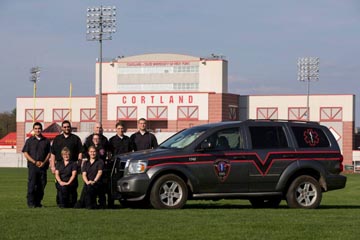
06/27/2016
There’s a quote that the student members of SUNY Cortland Emergency Medical Services (SCEMS) try to live by, one that appears in many of the group’s promotional materials and more noticeably in its work.
“You’ve never really lived until you have done something for someone who can never repay you,” the quotation goes.
When it comes to student clubs and organizations, few can claim the collective amount service of SCEMS, which celebrates its 40th year on campus in 2016.
The emergency response group is staffed by student volunteers 24 hours a day, seven days a week when classes are in session. They’re highly trained in basic life-support skills, with at least one certified New York state emergency medical technician on crew at all times. They work closely with SUNY Cortland’s University Police Department, TLC Medical Transportation Services and the City of Cortland Fire Department.
And the value of their volunteer hours can’t be overstated.
 |
| Members of SUNY Cortland EMS from the 2015-16 academic year. |
During the 2015-16 academic year, SCEMS provided 9,570 hours of emergency medical care to SUNY Cortland’s campus. The approximate value of those hours, based on a New York state estimate for 2015, was more than $257,000.
The organization’s motivation, however, has nothing to do with recognition or awards, even though many have come over the years.
“It’s about community,” said Justin Margolies, a four-year member who will serve as chief during the 2016-17 academic year.
The senior athletic training major from Syosset, N.Y., said he remembers his freshman year, walking down the hallway that connects VanHoesen Hall to the College’s Education Building, near the glass entrance to the SCEMS front office. He was shy and reserved, with little understanding of the emergency response world or its protocols.
“I saw that the front door of the office was open and I remember feeling good,” said Margolies, estimating that SCEMS will welcome back approximately 60 active members in the fall. “That’s important … We make sure to always leave our door open when someone’s in the office so that everyone knows they’re accepted.”
 |
| Justin Margolies |
Whenever a 911 call is made from SUNY Cortland’s campus, SCEMS responds to perform an initial patient assessment. Even though SCEMS cannot provide ambulance transportation to local hospitals, the organization never misses calls, which average more than one per day when classes are in session. The past year included a Central New York Call Commendation for Welly Ekoumilong ’16 and John Ingardia ’16, the organization’s former chief, for the care of an 18-year-old patient experiencing respiratory distress.
“EMS culture is very unique … It’s an atypical student group,” said Marley Barduhn ’76, M.S.Ed. ’79, the College’s assistant provost emerita and a member of the organization’s advisory board for almost 40 years. “These are certified healthcare professionals who also happen to be students and they’re looking after thousands of people every day.”
Student members represent all majors: from the expected ones such as biology and health to childhood education, geology and international studies. The bonds that unite them are unselfishness and a willingness to serve. And they’re qualities that stay with members long after their SUNY Cortland graduations.
“It’s an organization that cultivates this uniquely awesome brand of human,” said Matt Green ’12, a former SCEMS chief who today works as an emergency operations communications specialist for the Port Authority of New York and New Jersey Office of Emergency Management. “No one’s paying them … What they get in return is the opportunity to be better and to grow.”
 |
| Matt Green ’12, right, pictured with Rebecca Schwartzman ’12 and Austin Glickman ’12. |
For Green, that meant pairing leadership experience in SCEMS with his degree in new communication media. He’s still a licensed emergency medical technician (EMT), but his job today involves communicating crucial emergency preparedness information — mostly through social media — for an organization that oversees one of the busiest transportation areas in the world.
“My Cortland experience has been the critical foundation for all of my professional accomplishments,” said Green, who previously worked as an EMT during Hurricane Sandy and founded an emergency management consulting business with former SCEMS leader Austin Glickman ’12.
Barduhn said she notices common traits — most noticeably a sense of responsibility and altruism — in every member, past and present. A certified and experienced emergency medical professional herself, she advised the group when members carried 70 pounds of equipment on their calls. She supervised when SCEMS staffed a James Taylor concert in the early 1980s and a campus visit from poet Maya Angelou. And, like many, she was devastated in 2011 when Michael C. Holland, another former advisor, died suddenly from a heart attack during a trip to help flood victims in New York state’s Southern Tier.
Margolies credited a strong nine-member advisory team and an active SCEMS alumni network, especially among recent graduates, with creating the solid foundation for current members. Young alumni have gone on to careers as paramedics and police officers as well as teachers, lawyers and athletic trainers. Yet they still return to the organization’s annual awards banquet to offer relevant career advice and guidance.
Past chiefs like Green keep in contact with current leaders like Margolies to answer their everyday questions. A SCEMS Alumni Facebook group includes approximately 150 members. And the club’s headquarters, which includes couches and beds for overnight crews, remains home to everyone, even after they graduate.
“The people who supported me then are the same people who support me now,” Green said. “They’re the type who are always there for you and everyone else around them.
“It’s still this giant family.”